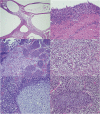DICER1 mutations in childhood cystic nephroma and its relationship to DICER1-renal sarcoma
- PMID: 24481001
- PMCID: PMC4117822
- DOI: 10.1038/modpathol.2013.242
DICER1 mutations in childhood cystic nephroma and its relationship to DICER1-renal sarcoma
Abstract
The pathogenesis of cystic nephroma of the kidney has interested pathologists for over 50 years. Emerging from its initial designation as a type of unilateral multilocular cyst, cystic nephroma has been considered as either a developmental abnormality or a neoplasm or both. Many have viewed cystic nephroma as the benign end of the pathologic spectrum with cystic partially differentiated nephroblastoma and Wilms tumor, whereas others have considered it a mixed epithelial and stromal tumor. We hypothesize that cystic nephroma, like the pleuropulmonary blastoma in the lung, represents a spectrum of abnormal renal organogenesis with risk for malignant transformation. Here we studied DICER1 mutations in a cohort of 20 cystic nephromas and 6 cystic partially differentiated nephroblastomas, selected independently of a familial association with pleuropulmonary blastoma and describe four cases of sarcoma arising in cystic nephroma, which have a similarity to the solid areas of type II or III pleuropulmonary blastoma. The genetic analyses presented here confirm that DICER1 mutations are the major genetic event in the development of cystic nephroma. Further, cystic nephroma and pleuropulmonary blastoma have similar DICER1 loss of function and 'hotspot' missense mutation rates, which involve specific amino acids in the RNase IIIb domain. We propose an alternative pathway with the genetic pathogenesis of cystic nephroma and DICER1-renal sarcoma paralleling that of type I to type II/III malignant progression of pleuropulmonary blastoma.
Figures





References
-
- Boggs LK, Kimmelstiel P. Benign multilocular cystic nephroma: Report of two cases of so-called multilocular cyst of the kidney. J Urol. 1956;76:530–541. - PubMed
-
- Joshi VV, Banerjee AK, Yadav K, et al. Cystic partially differentiated nephroblastoma: a clinicopathologic entity in the spectrum of infantile renal neoplasia. Cancer. 1977;40:789–795. - PubMed
-
- Murphy WM, Grignon DJ, Perlman EJ. Tumors of the kidney, bladder and related urinary structures. Washington DC. American Registry of Pathology. 2004;1:47–49.
-
- Delahunt B, Thomson KJ, Ferguson AF, et al. Familial cystic nephroma and pleuropulmonary blastoma. Cancer. 1993;71:1338–1342. - PubMed
-
- Priest JR, Watterson J, Strong L, et al. Pleuropulmonary blastoma: a marker for familial disease. J Pediatr. 1996;128:220–224. - PubMed
Publication types
MeSH terms
Substances
Grants and funding
LinkOut - more resources
Full Text Sources
Other Literature Sources
Medical

